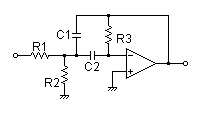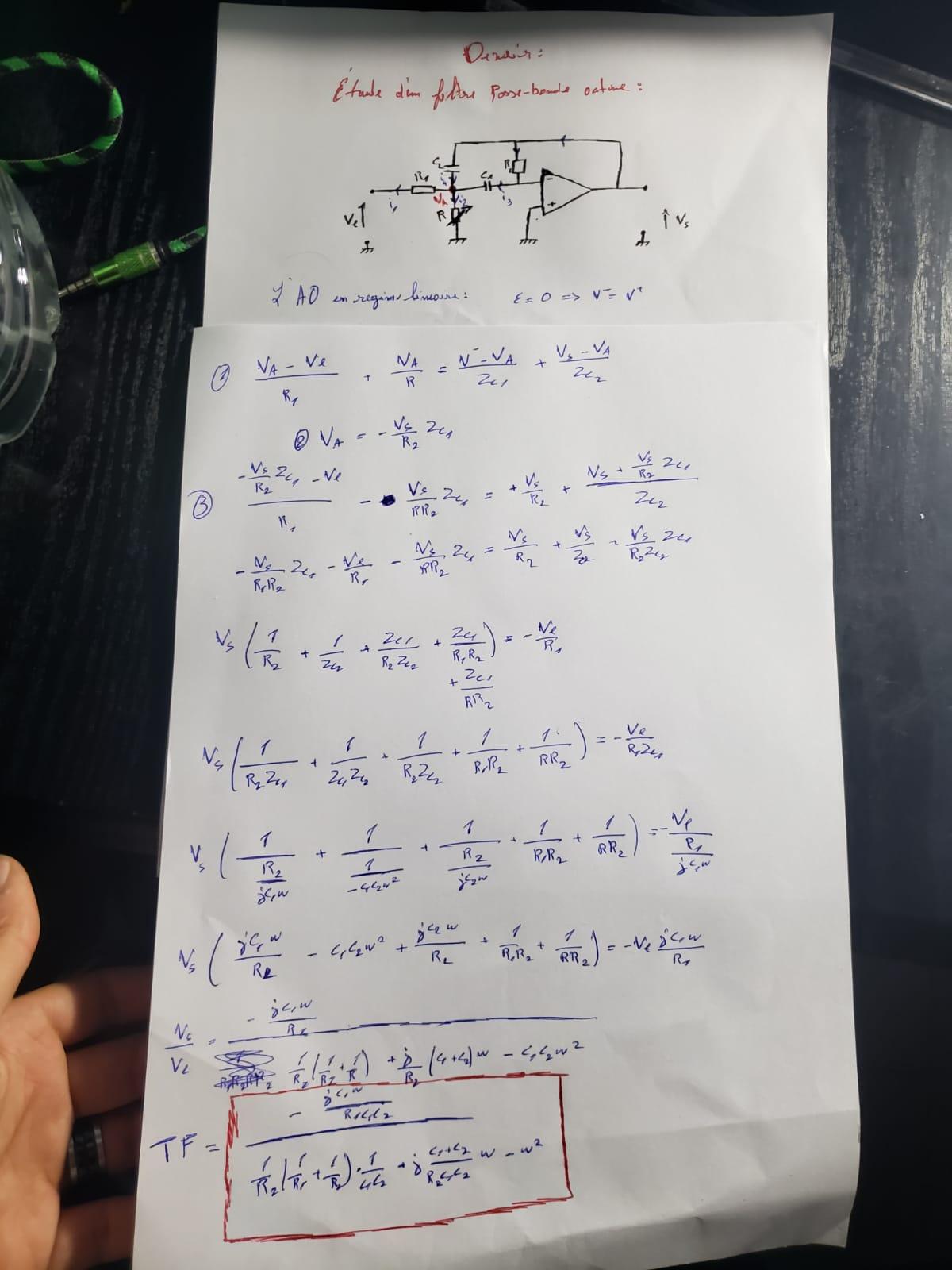Here, in sympy:
vi,vo,v1,v2,r1,r2,c1,c2,r3,io=symbols('vi,vo,v1,v2,r1,r2,c1,c2,r3,io',real=True)
s=symbols('s')
eqv1 = Eq(v1/r1+v1/r2+s*v1*c1+s*v1*c2,vi/r1+s*v2*c2+s*vo*c1)
eqv2 = Eq(s*v2*c2+v2/r3,s*v1*c2+vo/r3)
eqvo = Eq(vo/r3+s*vo*c1,io+s*v1*c1+v2/r3)
eqv2z = Eq(v2,0)
mfb = solve([eqv1,eqv2,eqvo,eqv2z],[vo,io,v1,v2])
mfb
{vo: -c2*r2*r3*s*vi/(c1*c2*r1*r2*r3*s**2 + c1*r1*r2*s + c2*r1*r2*s + r1 + r2),
io: (-c1*c2*r2*r3*s**2*vi - c1*r2*s*vi - c2*r2*s*vi)/(c1*c2*r1*r2*r3*s**2 + c1*r1*r2*s + c2*r1*r2*s + r1 + r2),
v1: r2*vi/(c1*c2*r1*r2*r3*s**2 + c1*r1*r2*s + c2*r1*r2*s + r1 + r2),
v2: 0}
mfb[vo]/vi
-c2*r2*r3*s/(c1*c2*r1*r2*r3*s**2 + c1*r1*r2*s + c2*r1*r2*s + r1 + r2)
Now, that's nicer (to me.)
I know that the general form should be \$K\frac{2\zeta\omega_{_0}s}{s^2+2\zeta\omega_{_0}s+\omega_{_0}^2}\$ or else \$K\frac{\frac1{Q}\frac{s}{\omega_{_0}}}{\left(\frac{s}{\omega_{_0}}\right)^2+\frac1{Q}\left(\frac{s}{\omega_{_0}}\right)+1}\$.
The first thing I look at is the denominator. That's because if I treat it as \$b_2s^2+b_1s+b_0\$ then it follows that \$\omega_{_0}=\sqrt{\frac{b_0}{b_2}}\$. In this case, \$\omega_{_0}=\sqrt{\frac{R_1+R_2}{R_1\,R_2\,R_3\,C_1\,C_2}}=\frac1{\sqrt{\left(R_1\,\mid\mid\,R_2\right)\,R_3\,C_1\,C_2}}\$. See how easy it is when you keep \$s\$ isolated?
The next thing is that I know \$Q=\frac{\sqrt{b_2 \,b_0}}{b_1}\$. I'll let you plug things in.
The final thing is that I know \$K=\frac{a_1}{b_1}\$ (given that the numerator -- did we forget about it? -- is \$a_2s^2+a_1s+a_0\$.) Again, you can plug things in here, too. (I think you will find that it agrees with your own example.)
(I can prove the above without difficulty. But it would take up space.)
Assuming all that's been done then you can make your substitutions:
$$\begin{align*}
K\cdot\frac{\frac1{Q}\frac{s}{\omega_{_0}}}{\left(\frac{s}{\omega_{_0}}\right)^2+\frac1{Q}\left(\frac{s}{\omega_{_0}}\right)+1}
\\\\
K\cdot\frac{\frac1{Q}\frac{j\,\omega}{\omega_{_0}}}{\left(\frac{j\,\omega}{\omega_{_0}}\right)^2+\frac1{Q}\left(\frac{j\,\omega}{\omega_{_0}}\right)+1}
\\\\
K\cdot\frac{\frac1{Q}\frac{\omega}{\omega_{_0}}j}{\frac1{Q}\left(\frac{\omega}{\omega_{_0}}\right)j+1-\left(\frac{\omega}{\omega_{_0}}\right)^2}
\end{align*}$$
You can work the algebra from there. But perhaps multiplying by \$\frac{-Q\frac{\omega_{_0}}{\omega}j}{-Q\frac{\omega_{_0}}{\omega}j}\$ might come to mind.
By the way, the \$H_{_0}\$ shown in the picture isn't quite the same as \$K\$. Instead, I believe \$H_{_0}=-K\$.


